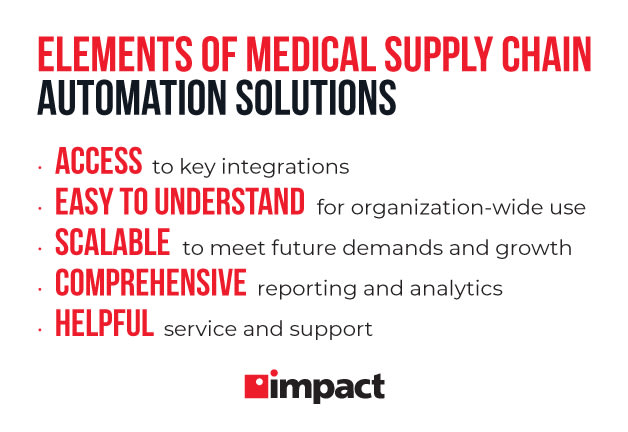Managing a supply chain in the healthcare industry can be complicated with so many moving parts, critical supplies, and physician preferences to balance, all while trying to lower costs and reduce waste. To help, businesses are implementing more automation than ever and using it to streamline processes that alleviate past pains.
What is Healthcare Supply Chain Management?
In healthcare, supply chain automation involves purchasing and distributing medical supplies and products for use in hospitals and other healthcare provider facilities.
The healthcare industry specifically faces unique difficulties in its supply chain due to product expirations, high demand for certain products, and theft.
Because of this, many providers find themselves ordering products they don’t need or ordering more than needed amounts of medication or supplies resulting in costly waste and loss of money.
Healthcare has a complex supply chain with many varying factors that affect purchasing, supply, shipping, and timing and, unlike many industries, a smoothly operating supply chain can have a significant impact not only on the healthcare businesses but on people’s health and lives.
Related: 5 Examples of Smart Technology in Healthcare
This is why it’s crucial that providers who suffer from inefficiencies in their supply chain find innovative solutions to streamline the process.
Elements of Medical Supply Chain Automation Solutions
What do businesses need in supply chain automation solutions? Here is a look at some of the key elements to look for:
Integrations: Be sure that your supply chain technology easily integrates with other software so you can connect all your systems.
Easy to Use: Easy-to-use systems empower your team by making it possible for more people within an organization to utilize the technology without substantial amounts of training.
Scalable: Make sure your automation technology can grow with you and continue to optimize new and changing processes.
Reporting: Information is king. Businesses must make sure they are getting access to the relevant data they need in impactful, useful ways.
Service: When support is needed, businesses need someone to rely on to help them solve problems, explore solutions, and implement them seamlessly into their operations. Excellent service is a must-have.
Benefits of Healthcare Supply Chain Automation
Automated Inventory Management
In healthcare, supply and inventory management can be extremely complicated with the amount of supplies needed and the importance of always having those supplies ready for patients and physicians.
Predictive Analytics
Hospitals and other providers often have access to loads of data on their processes, supply chain, inventory, and general operations but are unable to use it to the massive amounts in play.
Related: Big Data in Healthcare Explained
A human does not have the time to clean up the data, but with AI and automation, businesses can comb through the data to discover key insights that can help in numerous ways across operations, including improving patient care, streamlining processes, saving money, and reducing waste.
Predictive analytics allows providers to anticipate their own needs based on historical usage and order the right amount of supplies before they’re needed.
Reduced Waste and More Spending Reports
Automating supply ordering and inventory provides healthcare providers with more insights into their budget and spending and helps to reduce waste by eliminating over-ordering on perishable supplies.
This AI automation can help reduce spending overall by being able to explore the web for rebates and pricing changes from vendors to save as much money on ordering as possible. This process is typically done by humans, if done at all, but there is simply too much to analyze and find for humans to effectively perform the job.
Providers can save 17% when streamlining spending processes with automation
Physician Preference Card Standardization
To ensure every physician has the tools and supplies they need to perform their work, hospitals and healthcare providers use preference cards where physicians write what they need. Normally, this is a very time-consuming process done by humans who manually input data.
With automation, this work can be done by an AI who sifts through the cards, recording the supplies needed and automatically inputting that data into your automated inventory management system.
Additionally, AI can be used to find ways to streamline the process, clean up records and requests, and eliminate duplicate cards or requests, helping to reduce waste and costs.
In Conclusion
With new and innovative technologies becoming available, businesses in the healthcare industry must adapt to stay competitive.
One way to do this is with automation software taking over your supply chain management processes to increase efficiency, reduce waste, save money, and take a more proactive approach to managing inventory and supply.
Learn more about what it takes to have a modern supply chain with our new eBook available here or check our blogs and infographics on our resource center.
